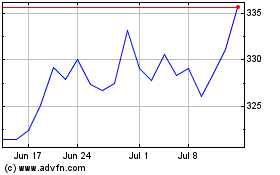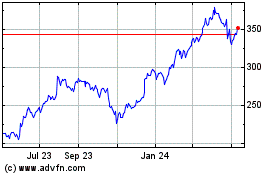Today's Top Supply Chain and Logistics News From WSJ
November 15 2017 - 7:29AM
Dow Jones News
By Brian Baskin
Sign up: With one click, get this newsletter delivered to your
inbox.
More products bear the "Made in the USA" label in the year since
Donald Trump's election, but economists say the new
administration's policies aren't behind the trend. A rebound in
global energy and commodity prices and steady worldwide economic
growth are fueling a steady rise in U.S. manufacturing jobs and
spending on new equipment and plants, the WSJ's Andrew Tangel and
Josh Zumbrun write. The gains have come without the tariffs and
penalties for outsourcing jobs that Mr. Trump has at times
threatened to implement, with manufacturers crediting improved
automation technology in addition to strong global demand. This
year's recovery hasn't changed some fundamental trends in how
companies structure their global supply chains. While manufacturers
like Caterpillar Inc. that serve commodity industries are
benefiting from booming U.S. harvests, clothing makers continue to
move production offshore. And some of the gains seen this year
could be quickly reversed if the economy slows or countries put up
new barriers to trade.
Some real-estate investors think brick-and-mortar retail isn't
dead yet. In the wake of Brookfield Property Partners LP's $14.8
billion bid for mall operator GGP Inc., other top-tier malls are
expected to become takeover targets, the WSJ's Esther Fung reports.
Malls have been bottom of the barrel in the real-estate market in
recent years, with buyers spooked by a steady parade of retail
bankruptcies. Owners counter that plenty of malls still attract
crowds, particularly locations targeting affluent shoppers. And as
traditional retailers exit, malls are finding other ways to fill
empty storefronts, including restaurants and attractions. Some are
trying to lure trendy brands that do most of their business online,
offering favorable leases to brands like Untuckit and Warby Parker
that appeal to younger shoppers. The budding revival in mall
operators' fortunes is a reminder that for all of the growth in
e-commerce over the last decade, the vast majority of shopping
still takes place in stores - and Brookfield is betting that's not
going to change anytime soon.
U.S. trade negotiators are doubling down on their "take it or
leave it" approach to re-negotiating the North American Free Trade
Agreement. Commerce Secretary Wilbur Ross told The Wall Street
Journal CEO Council that Mexico and Canada have more to lose from
the pact's demise, giving the U.S. an upper hand in trade talks.
Mr. Ross's statements are a sign that the Trump administration is
sticking to its guns on trade, with Nafta negotiations deadlocked
and U.S. participation in the Trans-Pacific Partnership off the
table. It's true that as the world's largest economy, the U.S. is
in pole position in most trade negotiations. But that doesn't mean
potential partners don't have other options if they feel they've
been pushed too far. A group of 11 nations is reviving TPP talks
that exclude the U.S., and Mexico has courted Chinese investment as
a lifeline should its U.S. trade ties fray. Many U.S. business
leaders agree, worrying American auto makers and farmers could be
among the losers if Nafta is dismantled.
AIRFREIGHT
Airbus SE is in a tug-of-war with one of its biggest customers
over a significant part of its production line. Emirates Airline is
stepping up pressure on the plane maker to keep producing its A380
super jumbo for at least another decade before it places any more
orders, the WSJ's Robert Wall reports, even though the jet is
losing money for Airbus and faces foundering support in the rest of
the aviation world. The demand is an aggressive negotiating ploy
and highlights how the Airbus's troubled plane now depends on
backing from just one airline. The stance from Emirates pushes
Airbus into a corner while the manufacturer is trying to reset its
supply chain and pull away from a $20 billion program that hasn't
produced profits after a decade of production. With 100 of the jets
in its fleet, 42 on order and another 30 under negotiation,
Emirates seems to be saying that the real control of the production
rests with the customer.
QUOTABLE
IN OTHER NEWS
The Wall Street Journal ranks top contenders for Amazon's new
headquarters. (WSJ)
Canada plans to escalate its legal fight against the U.S.
Commerce Department's decision to slap tariffs of roughly 20% or
more on Canadian lumber imports. (WSJ)
White House economic adviser Gary Cohn says the Trump
administration could begin discussions with lawmakers about an
ambitious infrastructure package in the coming weeks. (WSJ)
U.S. household debt hit a record of nearly $13 trillion last
quarter. (WSJ)
Foxconn Technology Group's profits plunged amid iPhone
production problems. (WSJ)
The operator of TJ Maxx, Marshalls and HomeGoods reported no
sales growth for the first time since 2009. (WSJ)
Indonesia's apparel manufacturing sector is booming as retailers
look for alternatives to China's rising labor costs. (Business of
Fashion)
Ceva Logistics cut its third-quarter loss nearly in half to $22
million on double-digit gains in air and ocean freight volumes.
(Air Cargo News)
Taiwan's Yang Ming Transport Ltd. is considering ordering 20
container ships, including a mix of mega-ships and feeder vessels.
(Splash 24/7)
The Georgia Ports Authority approved the Mason Mega Rail
Terminal project to double on-dock rail capacity. (Business in
Savannah)
E-commerce is driving up demand for air freight outside the peak
season. (Journal of Commerce)
U.S. ports say they face a shortage of customs inspectors. (The
Loadstar)
Australia Post is testing a "mobile parcel locker" to deliver
packages to homes. (The Guardian)
Ethiopian Airlines agreed to buy four Boeing Co. 777 freighters
in a deal worth $1.3 billion. (Associated Press)
ABOUT US
Brian Baskin is editor of WSJ Logistics Report. Follow him at
@brianjbaskin, and follow the entire WSJ Logistics Report team:
@PaulPage , @jensmithWSJ and @EEPhillips_WSJ. Follow the WSJ
Logistics Report on Twitter at @WSJLogistics.
Write to Brian Baskin at brian.baskin@wsj.com
(END) Dow Jones Newswires
November 15, 2017 07:14 ET (12:14 GMT)
Copyright (c) 2017 Dow Jones & Company, Inc.
Caterpillar (NYSE:CAT)
Historical Stock Chart
From Mar 2024 to Apr 2024

Caterpillar (NYSE:CAT)
Historical Stock Chart
From Apr 2023 to Apr 2024
